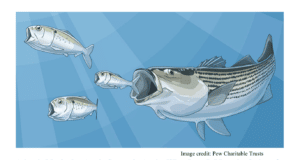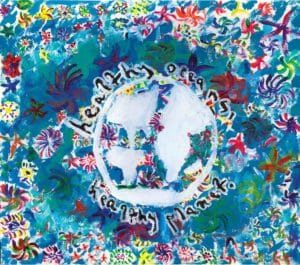As the saying goes, there’s a fine line between love and obsession. And no one knows this better than boaters. We arrange our lives around the wind and tides, spend mountains of hard-earned cash, and endure the wrath of those who think our boats have replaced them on our priority list. To most, it looks like lunacy. But it’s not, as the average boater knows how to keep his passion under control. Then, of course, there are the few who can’t. Curious to see what demons drive them to excess, we tracked down four who went over the top and never came back. What we found were boaters who were willing to spend without thought or reason, abandon lucrative careers, and lose themselves in something bigger than plain old boating. Call them eccentric, mad, or charmingly wacky. But as you read their stories, we dare you not to find that, somewhere down deep, they aren’t that far removed from you. Yup, it’s a fine line indeed.
[ The Fish Lover ]
Growing up on the Chesapeake Bay, Bud Hein surrounded himself with all things fishy, in terms of work and playtime. But a few years out of high school, while working in a marina, he began to wonder if fishing was just a boyhood infatuation. Thinking he needed to get into a more serious long-term relationship, Hein enrolled in college and emerged with a degree in photography. From there he went to New York, apprenticed, and opened his own studio.
True love, however, has a way of standing the test of time. When Hein returned from an assignment in London to discover his wife had moved out, he began to wonder if it wasn’t time for a change. During a soul-searching day on the water with his father, Hein had an epiphany. Photography paid the bills but it wasn’t his true love. His true love was fishing.
So at the age of 37, he moved back to the Chesapeake. He held on to a few accounts in New York, but his passion and time had been taken over by making lures-mostly bucktails for use on his home waters. Soon they became popular enough that Hein chucked his camera. His life had come full circle. “I was making a living,” recalls Hein. “Not a great one, but I was getting by. And I was fishing like crazy.”
Not long after, the owner of a local tackle store mentioned that he was thinking of retiring and wondered if Hein would like the shop. “I bought him out and I’ve been here for 13 years,” says Hein. “I always said I’m gonna have a tackle store one day, and this one just happened to fall in my lap.” Now, looking squarely at the big 5-0, Hein doesn’t regret a single minute. “I never have a problem getting up and coming to work in the morning, I’ll tell you that,” he says with a chuckle. Yes, the hours are long and the money isn’t what he was making as a photographer. “Still, I love every minute of it. It can be grueling, but it was definitely the right choice.”
[ The Collector ]
Like the animal lover who can’t walk away from a homeless pup, Lawrence “Bud” Woodward can’t resist a stray. And like that same pet lover, Woodward’s home – as well as those of his friends, acquaintances, and clients – is overflowing with the neglected souls he’s brought home, which in this case are vintage wood boats. “Back in the 1960s and 1970s, people were throwing these boats away, cutting them up for firewood,” says Woodward with a cringe. “I started collecting whatever I could save.” Eventually, it got to the point where he was so well-known that people would call him to take their old woody. “Naturally, I always said yes,” laughs Woodward.
Today, he can tell tales of nearly 20 boats that he’s saved and restored. His first was a 1947 Chris-Craft Sportsman named Teddy Bear; his latest, a 1935 Garwood 22 triple cockpit. With each he has affectionately reworked both lumber and leather and given new life to aging engines. A big investment in money and time. “I used to survive on a lot less sleep. I’d go out after dinner and work in the barn until one, maybe two o’clock in the morning,” explains Woodward. “I don’t put in as much time now, but it’s still so all-consuming and enjoyable that it’s easy to lose track of time.”
In the early days, Woodward entered his boats in shows. Now he feels he has little in common with people who spend tens of thousands of dollars in professional restorations to go after a $10 cup. “That’s not what I’m doing this for,” he says. “I do it because I enjoy it. It’s a hobby.” He also uses the boats whenever possible, putting them in the water as their builders intended.
Now, Woodward says, he’s been trying to cut back by selling off a few boats he feels aren’t significant. But cutting back still leaves him with 15 favorites – a glorious collection of Garwoods and Hackers that he feels have a true elegance. “They’re so beautiful. Sometimes I go and visit them just to take a look,” he explains. “It’s my way of collecting art.”
Woodward knows he’s gone overboard. Most people restore a boat, sell it, and move on to the next project. “My problem,” he admits, “is that I fall in love with them during restoration…so I just keep them.”
[ The Web Guy ]
As a boy, Kelly Wood fell in love with the idea of boating. As a young adult, he finally had the means to join the club. So he decided to resurrect a faded fiberglass runabout from the weeds behind someone’s barn. Problem was, Wood had no idea what make boat it was, or what it should look like when finished. A computer technician by trade, he turned to the fledgling Internet to discover all he could about his mystery machine.
“I just thought I’d put together a goofy little Web site,” Wood remembers. “I started it in an attempt to find anybody else who owned a boat like mine.” Eventually, that “anybody” appeared and offered up the ultimate piece of swag, a copy of the original brochure for his boat – a 1965 Glasspar Super G. All for the low, low price of $40. “Needless to say, I paid the $40 because I had to have it,” recalls Wood. “But in the process, I realized I had just stumbled onto something.” From that, Fiberglassics.com was born, a Web site dedicated to people who, like him, are into resurrecting fiberglass runabouts. “Little did I know that the site would become something great,” he says. And an all-consuming obsession.
Today, Fiberglassics.com is the premier source of information on fiberglass boats from the golden era of glass, with not only an extensive library of original brochures (up to 100 at last count) but also message boards, picture galleries, restoration tips, and even sources for original replacement parts. The site counts more than 1,000 hits a day on its main page alone; 3,000 a day roam the message boards. “People see it as this giant enterprise, but little do they know it’s just me and my wife,” laughs Wood, who somehow finds time to hold down a real job at a computer software company.
Wood estimates he spends three to four hours every day maintaining and updating the site, and he frequently spends weekend afternoons scanning the mountain of brochures that enthusiastic owners are looking to share. He’s also a frequent poster on the message boards. And although regular users are invited to send in a $35 membership fee to help support the site, Wood insists that, unlike that first brochure, all the information provided is free of charge. “Last year was the closest I came to making any money,” says Wood, “I lost only $2,000.” That figure, however, shows progress – the year before he lost $5,000. “It takes the majority of my spare time,” says Woods. “But it’s real information, from the real people who love these boats as I do.”
[ The Traveling Man ]
**** When successful television director Bruce Kessler announced that he wanted to take a year or two off to cruise to Australia and pursue his goal of fishing the Great Barrier Reef, his agent uttered that classic Hollywood warning: “You’ll never work in this business again.”
Kessler, however, had a dream, and neither rational advice nor a future in Hollywood purgatory could shake him from it. “I said, well, if worse comes to worst and I never work again, that’s okay, too. But I’m going to take these years and go.”
And go he did. Accompanied by his wife, Joan Freeman, herself a working actress, he set out from Marina Del Rey in California aboard the 70′ trawler Spirit of Zopilote and headed Down Under, ultimately baiting that hook and fishing the reef of his dreams. Fade out to the credits? Nope. In his case it was more like the end of the first act.
When the time came to head back, Kessler found it challenging to ship his boat home. When friends suggested he take the boat to Singapore, where there are no loading fees, the story took an unexpected turn. This one-time fishing trip had now turned into something much more – a complete circumnavigation of the globe. “If I went to Singapore,” Kessler recalls, “why not continue on and summer in the Mediterranean and bring the boat home in the fall?” While that agent’s warning never panned out (Kessler was hired almost on the spot once he returned to Los Angeles), Kessler’s advice to other would-be dreamers is clear: “Follow it now, before something comes along to alter your script.”
He’s become adamant: “If you have a dream, a driving obsession, don’t wait. If you do, something will always happen to give you an excuse not to make it real. Have the courage. It was the best thing I ever did.” Cue the sunset over rolling seas.









